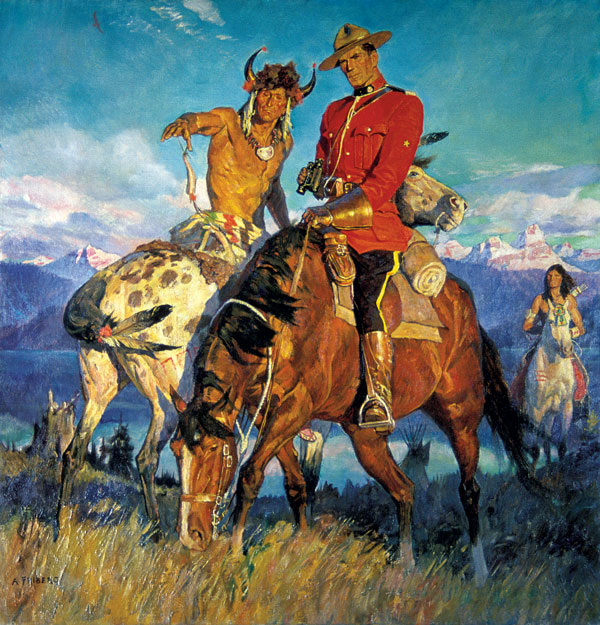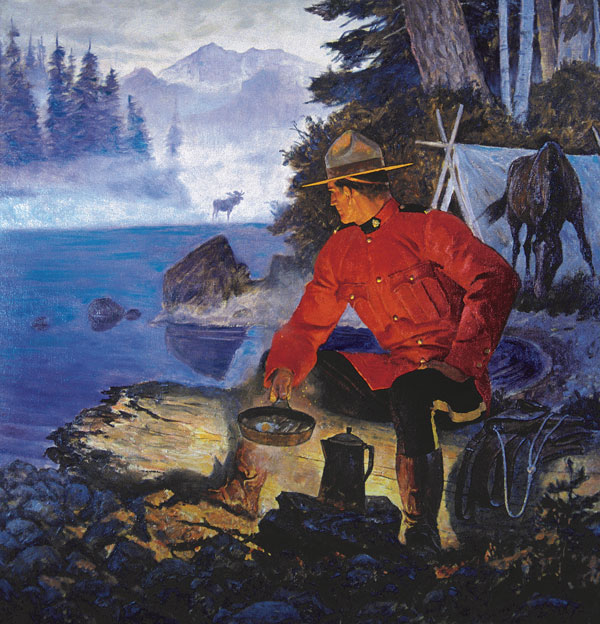Recruiting Imagery
To our American neighbours, Arnold Friberg is best known for his painting, The Prayer at Valley Forge — the haunting image of Washington praying in the bitter cold and snow during the Revolutionary War. To Canadians, he is the man that made the Royal Canadian Mounted Police the sexiest police force in the world.
Friberg was the painter of presidents and royalty, and he was famous for striking realism and historically correct imagery. He is considered one of the greatest master painters of modern times, but to him, his audience was “the guy down the street.”
The son of Scandinavian immigrants, Friberg was born Dec 21, 1913 in Winnetka, Illinois, a suburb of Chicago. Soon his family moved to Arizona, and his interest in art blossomed. He took art by correspondence and after graduating, enrolled at the Chicago Academy of Fine Arts, working in the commercial art field for several years.

Enter in the Northwest Paper Company of Minnesota. During the Depression the company was struggling, and they sought an advertising theme that would establish its product as strong, dependable, and consistently able to do the job well. The RCMP (the name was changed from North West Mounted Police in 1920) was already world-famous for these qualities, so by 1937, Friberg began painting classic RCMP officers for the company’s ad campaign.
Not surprisingly, the illustrations of the RCMP in their red serge uniforms were an instant advertising success. Sales — and the prestige of the force — skyrocketed. Ironically, for over 50 years, the famed Canadian RCMP served as the symbol for the American printing paper company.
In 1940, Friberg moved to New York City. While there, he enrolled in the Grand Central School of Art, where he studied alongside Norman Rockwell.
With the outbreak of World War II, Friberg left art school and joined the U.S. Army, serving in the 86th Infantry Division. He was assigned to G-2 Division, the intelligence section associated with spy missions and high adventure. Friberg spent the war scouting and map-making.
After the end of the war, he set up shop in San Francisco, married Hedve Baxter and by 1948 was a success with his Western paintings for the Louis F. Dow Calendar Company. By 1950, Hedve’s doctor recommended they move to a drier climate, so the young Mormon couple moved to Utah.

It was here that Friberg was asked to commemorate a centennial event by creating a painting of the first Sunday school taught by a member of the Church of Latter Day Saints. Friberg was next commissioned to create 12 paintings depicting the Book of Mormon for a magazine called The Children’s Friend. Shortly after, the Church chose to put all of Friberg’s paintings in the Book of Mormon.
These stunningly beautiful images caught the eye of film director, Cecil B. DeMille, who was searching for an artist to create previsualization paintings (storyboards) of his epic motion picture, The Ten Commandments. Starting in 1953, Friberg spent three years in Hollywood as DeMille’s chief artist and designer. Friberg’s paintings included costume design for the main characters, for which he received an Academy Award nomination.
Meanwhile, Friberg steadfastly maintained his art connection to Northwest Paper Company and was one of their most prolific contributors. Over some 40 years, he sold the company paintings or reproduction rights on 208 RCMP subjects. Years later, the value and importance of their large art collection saw Northwest (a division of Potlatch) select the Tweed Museum of Art, in Duluth, Minn., as curator and repository.
Thanks to his much-lauded work in portraying the Mounties and for his contributions to the RCMP Centennial, Friberg was their guest as Queen Elizabeth II was being presented with a new horse.

The presentation was in 1973 during the Mounties’ 100th year, hence the horse was named Centenial with one “n” deliberately dropped. The black gelding became a favourite of HRH The Prince of Wales, and in 1978, Friberg was commissioned to do an almost life-size portrait of Prince Charles with Centenial at Buckingham Palace. Later in 1990, Friberg and his wife were invited back to spend another six weeks painting an equestrian portrait of Queen Elizabeth II and the same mount.
Later, during the RCMP’s 125th Anniversary in 1998, Friberg created some artwork for “E” Division Mess (Mess is a military term and is usually where regimental officers dine.) In recognition, Friberg was made an honourary member of the “E” Division Mess, the only American to receive an honourary mess membership.
Throughout his career, Friberg painted railroads and wagon trains, mountain men and miners, Native Americans and religious figures, the U.S. Cavalry and the RCMP, canoes and sailing ships, wildlife and hundreds of horses. With his paintbrush, he symbolized a nation in its most desperate time at Valley Forge and defined a nation in its finest hour with his idealized portraiture of Canada’s greatest symbol — the red-serge-clad, larger-than-life RCMP member.
At 96, Friberg died on July 1, 2010. He is buried in Salt Lake City.














